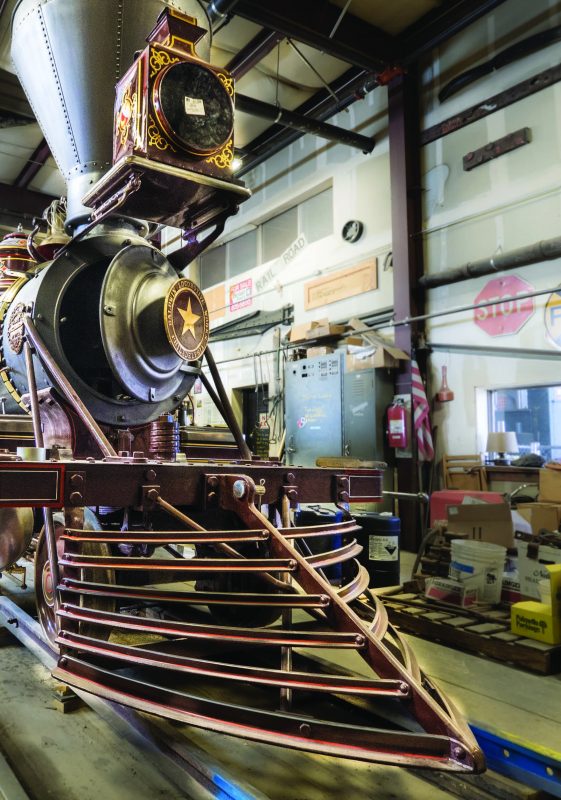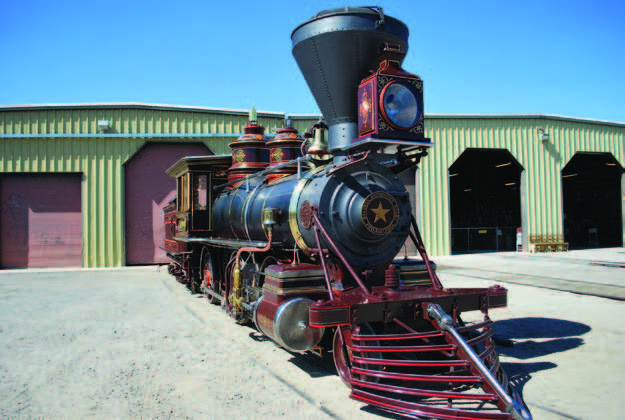The Glenbrook
May – June 2015
Historic Train Roars Back to Life.
BY WENDELL HUFFMAN
After slumbering for almost 90 years, the historic locomotive Glenbrook is once again under steam, blasting its whistle just a short distance from where it first started operating in 1875. This Memorial Day, the Nevada State Railroad Museum in Carson City is set to host the official unveiling of the newly restored locomotive, giving the public its first chance to see an incredible piece of the area’s history come to life. The Glenbrook—a narrow gauge, 2-6-0 locomotive—first ran as part of the railroad created by the Carson & Tahoe Lumber & Fluming Company (C&TL&F), which supplied mine timbers, lumber, and cordwood to the Comstock.
CARRYING THE COMSTOCK
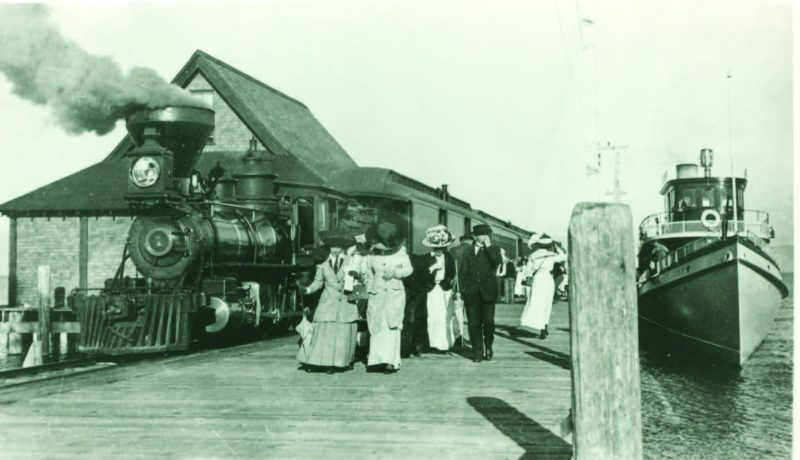 Logs were cut at various places around Lake Tahoe and towed by steamboats to the company’s sawmills at Glenbrook, a settlement on the Nevada side of the lake. Initially, the mill’s output was hauled by teams and wagons to Spooner Summit, and then floated down the eastern side of the Carson Range in a 12-mile flume. This flume terminated just south of Car- son City, at which point the timbers and cordwood were sent to Virginia City on the cars of the Virginia & Truckee Railroad. An eight-mile, three-foot gauge railroad between Glenbrook and Spooner eliminated the wagon haul in 1875. The Glenbrook and twin Tahoe locomotives pulled trainloads of timber products on this railroad for 24 years, until demand from the Comstock faded.
Logs were cut at various places around Lake Tahoe and towed by steamboats to the company’s sawmills at Glenbrook, a settlement on the Nevada side of the lake. Initially, the mill’s output was hauled by teams and wagons to Spooner Summit, and then floated down the eastern side of the Carson Range in a 12-mile flume. This flume terminated just south of Car- son City, at which point the timbers and cordwood were sent to Virginia City on the cars of the Virginia & Truckee Railroad. An eight-mile, three-foot gauge railroad between Glenbrook and Spooner eliminated the wagon haul in 1875. The Glenbrook and twin Tahoe locomotives pulled trainloads of timber products on this railroad for 24 years, until demand from the Comstock faded.
One of the principals of the C&TL&F was Duane L. Bliss, Lake Tahoe businessman and visionary. In 1895, the Lake Tahoe Transportation Co. was formed to operate the family’s steamboats, which served the lake communities. In 1898, to complete its transportation network, the Bliss family organized the Lake Tahoe Railway & Transportation Company (LTR&TCo.) to construct a 15-mile railroad along the Truckee River between Tahoe City and Truckee, where it connected with the trains of the Southern Pacific Railroad. In 1899, the rails and most of the equipment from the old C&TL&F lumber railroad were moved to the new operation at Tahoe City. The new railroad formally commenced operation in May 1900. The old locomotive Glenbrook became No. 1 on the LTR&TCo.
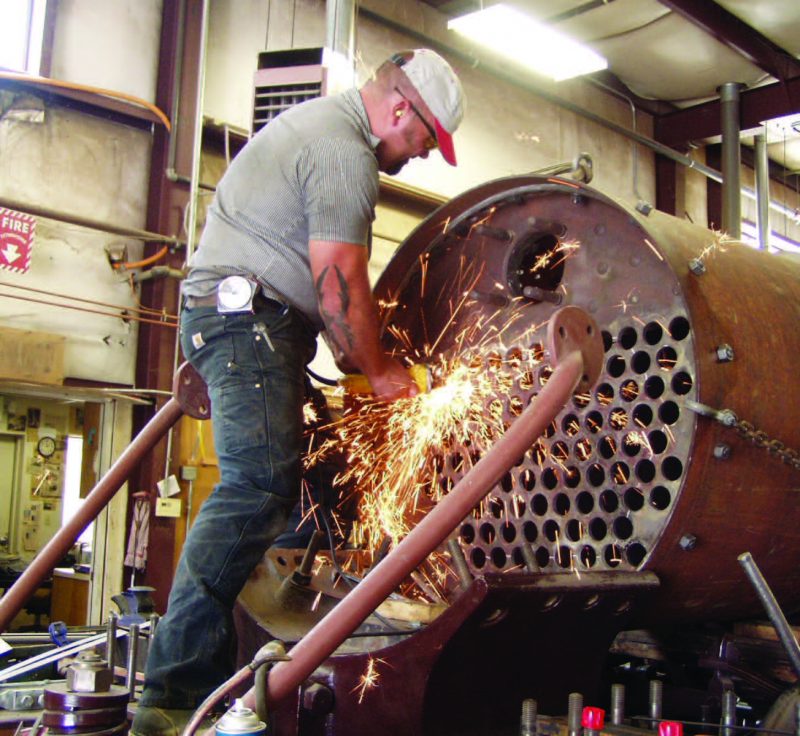 The narrow-gauge railroad operated for a quarter-century, carrying passengers and freight between Lake Tahoe and Truckee. However, the need to transfer freight and passengers between the standard gauge cars and narrow gauge cars at Truckee was a constant source of expense and irritation. In an effort to improve the lake’s connection to the outside world, the LTR&TCo. leased its railroad to Southern Pacific in 1925, with the proviso the railroad be converted to standard gauge. This was accomplished in 1926, and title to the railroad was transferred to Southern Pacific the following year. Recognizing the tourism value, Southern Pacific promoted its cross-Sierra mainline as the Lake Tahoe Route.
The narrow-gauge railroad operated for a quarter-century, carrying passengers and freight between Lake Tahoe and Truckee. However, the need to transfer freight and passengers between the standard gauge cars and narrow gauge cars at Truckee was a constant source of expense and irritation. In an effort to improve the lake’s connection to the outside world, the LTR&TCo. leased its railroad to Southern Pacific in 1925, with the proviso the railroad be converted to standard gauge. This was accomplished in 1926, and title to the railroad was transferred to Southern Pacific the following year. Recognizing the tourism value, Southern Pacific promoted its cross-Sierra mainline as the Lake Tahoe Route.
Most of the old narrow-gauge railroad equipment—including three of the line’s four locomotives—was scrapped. However, the Bliss family retained the Glenbrook with the intention of preserving and displaying it. For more than a decade, the old engine was stored at Tahoe City, but display arrangements were never realized. In 1937, it was sold to the Nevada County Narrow Gauge (NCNG) to provide needed parts for its old mate the Tahoe, which had been running on the northern California route since 1898.
With the abandonment of the NCNG in 1942, Hope Bliss, daughter of Duane, purchased the Glenbrook with the specific intention of donating it to the Nevada State Museum, which had been created in 1941. The Bliss family recognized the museum could preserve the Glenbrook. It was shipped by rail from Colfax to Carson City in June 1943 and was immediately set up on the museum grounds.
REBUILDING HISTORY
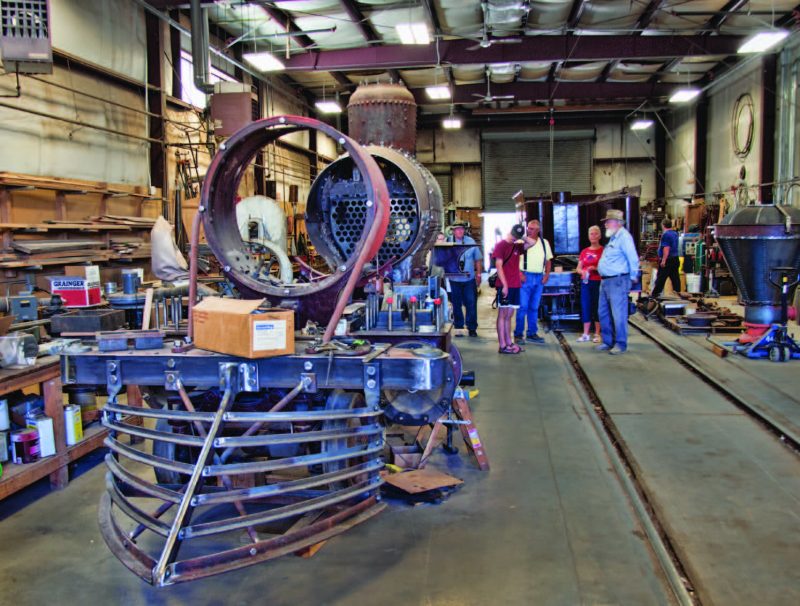 Eventual restoration of the locomotive was the goal in 1943, and a concerted effort was made to collect all of the parts which had been removed subsequent to its sale in 1937. Carson City Sheriff Harold Brooks and Museum Curator Percy Train rummaged through the NCNG engine house gathering parts, and NCNG master mechanic John Nolan retrieved the crosshead pump from the dirt floor of his garage, where he had hidden it from the scrapper. Builders’ plates to replace originals removed many years before were acquired from Baldwin. However, restoration was still a long way off.
Eventual restoration of the locomotive was the goal in 1943, and a concerted effort was made to collect all of the parts which had been removed subsequent to its sale in 1937. Carson City Sheriff Harold Brooks and Museum Curator Percy Train rummaged through the NCNG engine house gathering parts, and NCNG master mechanic John Nolan retrieved the crosshead pump from the dirt floor of his garage, where he had hidden it from the scrapper. Builders’ plates to replace originals removed many years before were acquired from Baldwin. However, restoration was still a long way off.
For nearly four decades, the Glenbrook was displayed outside the Nevada State Museum. It provided countless photo opportunities, and was a favorite of visiting schoolchildren who climbed aboard. Eventually, in July 1981, it was relocated to the Virginia & Truckee Railroad Museum (subsequently named the Nevada State Railroad Museum), which was then restoring several old pieces of Virginia & Truckee rolling stock. While significant restoration work was accomplished between 1981 and 1986, little was done in the following 23 years, as work on the McKeen car and the French 40 and 8 boxcar took precedent. Finally, restoration began in earnest in 2010 when funds from the E.L. Wiegand Foundation were awarded to support the project.
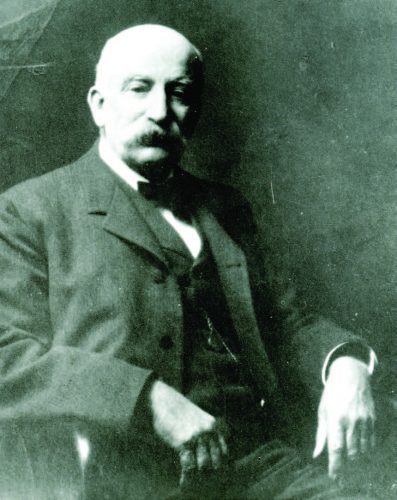 Initially the original riveted boiler was to be replaced with an entirely new one. However, this was eventually recognized as a serious compromise to the authenticity of the ultimate restoration, and the old boiler was carefully rebuilt using as much of the original material as possible. While getting the riveted boiler licensed for operation posed its own challenges, this was ultimately accomplished in November 2014, when the locomotive was tested under steam for the first time since 1925.
Initially the original riveted boiler was to be replaced with an entirely new one. However, this was eventually recognized as a serious compromise to the authenticity of the ultimate restoration, and the old boiler was carefully rebuilt using as much of the original material as possible. While getting the riveted boiler licensed for operation posed its own challenges, this was ultimately accomplished in November 2014, when the locomotive was tested under steam for the first time since 1925.
In addition to the boiler, as many of the locomotive’s original components as possible were used in the restoration, with a few parts manufactured using original Baldwin drawings. These include the smokebox front and the cab. The Glenbrook—Carson & Tahoe Flume & Lumber Company No. 1—is a genuine memento of the Comstock and it also supported Nevada’s fledgling tourism industry. While the initial attempt by the Bliss family to preserve the locomotive was not successful, they nevertheless spared the locomotive from destruction. With their donation, the Glenbrook became the first railroad artifact to be owned and preserved by the Nevada State Museum. After some 34 years of on-again, off-again restoration, when the Glenbrook was started in 2015 it was the first time its whistle has been heard in 89 years.
THE BIG REVEAL
The Glenbrook will make its grand debut Saturday, May 23, at the Nevada State Railroad Museum in Carson City. Ceremonies begin at 11 a.m. with representatives of the E.L. Weigand Foundation, the organization that provided grant funding to restore this piece of Nevada’s history. Descendants of the Bliss family will be present along with museum, tourism, and elected officials.
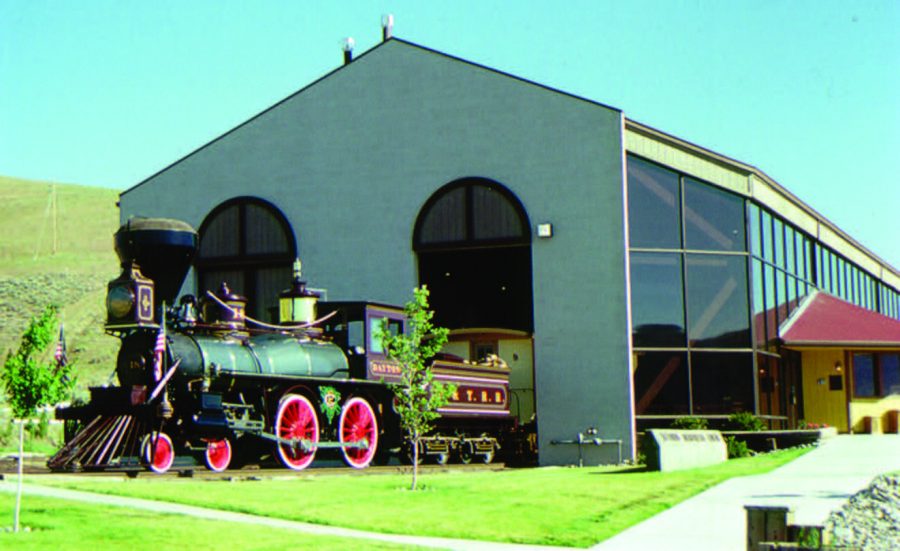 After 31 years of heartfelt care by the museum’s restoration staff, the locomotive will run on narrow gauge tracks under full steam. The 1875 standard gauge Inyo—the museum’s signature steam locomotive normally only in use on Fourth of July— will also be operational. Visitors will be able to photograph both the Inyo and Glenbrook, but the two will not pull cars or carry passengers. The V&T steam Locomotive #25 will power the train of historic railcars, offering rides throughout the holiday weekend. Locomotives will be on display outside as well. Admission to the Nevada State Railroad Museum is $6. Train rides are $8 for adults and $4 for children 3 to 11. Visitors can view the Glenbrook whenever the museum is open; call before visiting for hours. The locomotive will also operate on special occasions.
After 31 years of heartfelt care by the museum’s restoration staff, the locomotive will run on narrow gauge tracks under full steam. The 1875 standard gauge Inyo—the museum’s signature steam locomotive normally only in use on Fourth of July— will also be operational. Visitors will be able to photograph both the Inyo and Glenbrook, but the two will not pull cars or carry passengers. The V&T steam Locomotive #25 will power the train of historic railcars, offering rides throughout the holiday weekend. Locomotives will be on display outside as well. Admission to the Nevada State Railroad Museum is $6. Train rides are $8 for adults and $4 for children 3 to 11. Visitors can view the Glenbrook whenever the museum is open; call before visiting for hours. The locomotive will also operate on special occasions.
AT THE MUSEUM
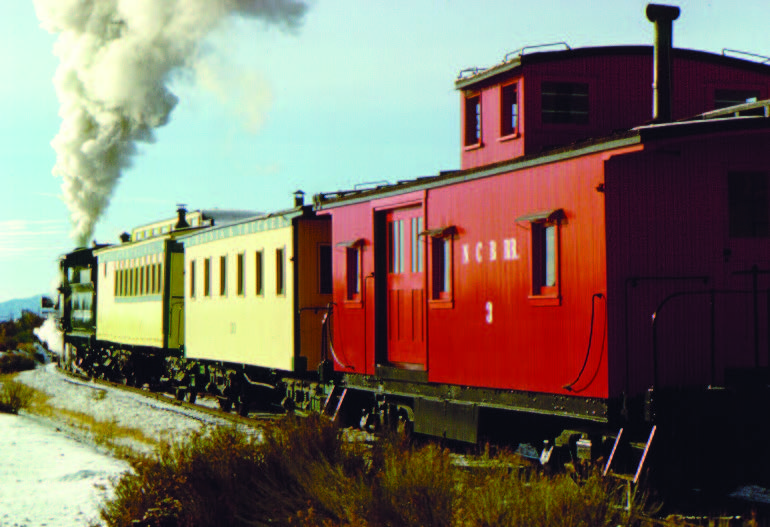 The Nevada State Railroad Museum in Carson City preserves the railroad heritage of Nevada, including locomotives and cars of the famous Virginia & Truckee Railroad and other railroads of the Silver State. Museum activities consist of operation of historic equipment, including train rides, handcar rides, lectures, an annual railroad history symposium, changing exhibits, and special events. Don’t miss the kid-sized locomotive Whistlin’ Billy, a perfect hands-on experience where kids can climb aboard a pint-sized locomotive, made just for them.
The Nevada State Railroad Museum in Carson City preserves the railroad heritage of Nevada, including locomotives and cars of the famous Virginia & Truckee Railroad and other railroads of the Silver State. Museum activities consist of operation of historic equipment, including train rides, handcar rides, lectures, an annual railroad history symposium, changing exhibits, and special events. Don’t miss the kid-sized locomotive Whistlin’ Billy, a perfect hands-on experience where kids can climb aboard a pint-sized locomotive, made just for them.
The centerpieces of the museum’s main building are the Inyo No. 22 and the Virginia & Truckee No. 27, both standard-gauge locomotives. In addition to these impressive machines, the main building offers many ways to learn about the history of Nevada’s railroads. From scale models to dioramas, informational plaques to locomotives and cars rarely seen, this museum is a must for anyone who loves railroads, Nevada history, or just a very cool look back in time.
For an even closer look, take a tour of the storage facilities behind the main museum (check with staff first). Stored in this massive building is the McKeen Motor Car, the V&T Railroad Coach No. 17—which may have carried the Golden Spike to Promontory, Utah, at the completion of the Transcontinental Railroad—the French National Railways 40 and 8 “Merci” Car, and many others.
Many of the cars at the museum were bought from Hollywood studios, where they were made famous in movies and television. Among the 65 locomotives and cars in the collection, 40 were built before 1900. There are more than 30 pieces that operated on the V&T line alone.
ALL ABOARD!
Nevada State Railroad Museum
2180 S. Carson St. Carson City, NV 89701 nsrm-friends.org
775-687-6953

